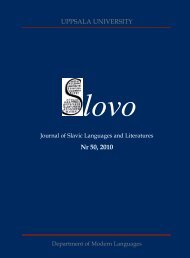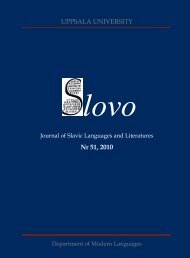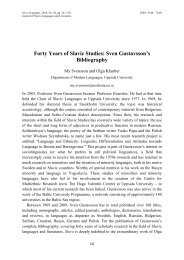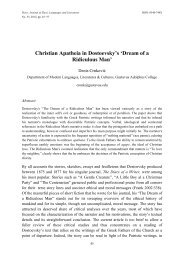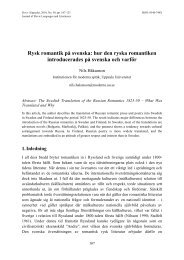Full text PDF - Index of - Uppsala universitet
Full text PDF - Index of - Uppsala universitet
Full text PDF - Index of - Uppsala universitet
You also want an ePaper? Increase the reach of your titles
YUMPU automatically turns print PDFs into web optimized ePapers that Google loves.
Slovo.<br />
Journal <strong>of</strong> Slavic Languages and Literatures<br />
(27) Før bestefar hugget grantreet, pleide han å ta seg en røyk og en god snus og le<br />
litt av den forfrosne Vanka [...] (Norwegian)<br />
The interpretation <strong>of</strong> the embedded imperfective present tense in the example above is<br />
obviously not deictic, hence the temporal location <strong>of</strong> the embedded event does not<br />
directly depend on the utterance time. Interestingly, we can also have a perfective<br />
present (no less!) under byvalo, cf. the continuation <strong>of</strong> the Čechov story from example<br />
(1) above:<br />
(28) [Всё, бывало, с ней через забор разговариваю и под конец, чтобы<br />
недалеко было ходить, сделал я в заборе калиточку.] Я ходил к ней и по<br />
человечности носил ей чайку, сахарку. А она, бывало[up], увидит[un,upf]<br />
меня и начнет[un,upf] трястись всем телом, машет[un,uipf] руками и<br />
бормочет: “Уйди!” (Anton Čechov, “Baby”)<br />
(29) I went to see her, and from Christian charity I took her a little tea and sugar.<br />
But as soon as she set[up] eyes on me she began[up] to shake all over,<br />
wringing[uipf] her hands and muttering: “Go away! go away!”<br />
(30) Jeg besøkte henne og av humanitet hadde jeg med til henne te og sukker. Men<br />
når hun fikk[up] se meg, begynte[up] hun å ryste over hele kroppen, vinke<br />
med hendene og mumle: “Gå vekk!” (Norwegian)<br />
We shall return to this puzzling aspectual choice in Section 7. But how do we make<br />
sense <strong>of</strong> the present tense morphology under byvalo? In the rich literature on Russian<br />
tense and aspect I have not been able to find any explicit and fully developed analysis<br />
<strong>of</strong> these constructions. 6 However, Paslawska and von Stechow provide the key notion<br />
for a proper understanding <strong>of</strong> byvaet/byvalo in combination with present tense<br />
morphology, namely the notion <strong>of</strong> bound tense:<br />
“The perfective present form [can be] embedded under a habituality operator that gives us a large<br />
interval surrounding the speech time. Within that interval, the PERFECTIVE may localize the event<br />
time. The IMPERFECTIVE is possible under the habituality operator as well, <strong>of</strong> course. The<br />
surrounding time span can be introduced explicitly, e.g. the verb byvaet ‘it happens’. [...] Arguably,<br />
the present in the subordinate doesn’t denote the speech time, it rather is a bound variable.”<br />
(Paslawska & von Stechow 2003:336–337)<br />
Since the embedded present tense morphology obviously cannot be ascribed a deictic<br />
interpretation, the only reasonable alternative is to assume some kind <strong>of</strong> dependence<br />
on the verbal quantifier byvalo. Arguably byvalo, like attitude verbs, controls (binds)<br />
the temporal parameter <strong>of</strong> the embedded predicate. In the case <strong>of</strong> byvalo, this time is<br />
not the “subjective now”, but some con<strong>text</strong>ually relevant subinterval <strong>of</strong> the habitual<br />
time span. This embedded predicate is just as “tenseless” as temporal propositions<br />
under attitudes, hence present tense morphology is licensed in Russian in accordance<br />
with the SOT parameter.<br />
6 As pointed out by two <strong>of</strong> the reviewers, the use <strong>of</strong> the perfective present in these constructions is known as the<br />
primerno-nagljadnoe značenie in traditional Slavic aspectology. However, the mere labelling <strong>of</strong> the construction<br />
does not amount to providing an analysis. In this paper I try to go one step further by subsuming this puzzling<br />
construction under a more familiar phenomenon, viz. complement tense under attitude verbs.<br />
70



